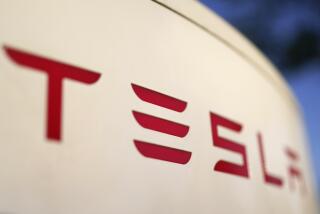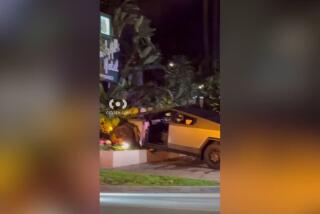Tesla’s top safety rating comes with fine print
Is the Tesla Model S really the safest car on the road?
One key fact went unnoticed this week as Tesla Motors Inc. trumpeted its “best” crash-test rating in the media: The federal government doesn’t test most other luxury cars.
So the Model S may be safer than many cars costing far less. But whether it’s safer than direct competitors from BMW, Audi and Mercedes-Benz — considered among the safest cars available — remains a mystery.
What’s more, the federal safety regulators privately reprimanded the automaker for publicly claiming the Model S scored better than any other car, according to a source familiar with the discussions. In fact, Tesla is among seven cars since 2011 that received the highest rating in all categories, according to the National Highway Traffic Safety Administration.
Knowing safety is a top consumer priority, automakers often use crash-test data to hype their vehicles. But the tests are just one measure of safety and can often provide a skewed picture, experts say.
“Safety in the tests is different than safety on the road,” said Clarence Ditlow, director of the Center for Auto Safety, an independent advocacy organization.
Crash tests only measure the damage after things go horribly wrong.
Say you are driving a Model S at 35 mph and look down at a text on your phone and — bam! You’ve just rear-ended a car. The 4,800-pound car, with big crumple zones to absorb the impact, sustains major damage but protects you from injury.
Take the same scenario in a Mercedes-Benz S-class, a big German sedan that competes with the Tesla. You look down at the text and suddenly feel your brakes slam — even though your foot is still on the gas. You stop before hitting the car.
That’s because the Mercedes, like many other luxury cars, is equipped with forward collision avoidance sensors with automatic braking, a feature Tesla doesn’t offer.
“Tesla clearly does the best overall in the test-crash scores,” Ditlow said. “But when you put that car on the road, I suspect it will do poorer than a car like the Mercedes.”
Ditlow lists a host of other Mercedes technologies that prevent accidents but don’t appear in test-crash data. Adaptive cruise control tracks the speed of cars ahead and maintains a safe distance. Another system alerts the driver when the car is about to stray from its lane. Headlights automatically adjust to better illuminate the road.
The Model S doesn’t have those features but Tesla may look into integrating them in the future, said Shanna Hendriks, the Palo Alto electric-car company’s spokeswoman. “We believe the impact active safety features have on a car’s overall safety is marginal,” she said.
The Insurance Institute for Highway Safety disagrees. Forward collision systems with automatic braking have cut property damage claims on some Mercedes and Acura models 14%, according to the institute, an industry research group that operates its own testing program.
More important, they cut bodily injury claims, made when the insured hurts someone in another vehicle, by 16% in the Mercedeses and 15% in the Acuras.
Another way to judge safety is the number of deaths in a particular vehicle. For model years 2005 through 2008, death rates tracked over three years ending in 2009 ranged from a high of 143 per million cars in the Nissan 350Z to zero for seven different models.
The models with no deaths included the Audi A6, the Mercedes E-Class, the Toyota Sienna, Ford Edge, Nissan Armada and two Land Rovers.
In real-world driving, both the Model S and the Mercedes provide “supreme safety” thanks to their hefty mass, passenger-protecting crumple zones and other features, said Jeff Bartlett, a Consumer Reports automotive editor.
“Dramatic accidents that might set them apart would be so rare,” Bartlett said.
But crash-test comparisons simply aren’t available for most luxury cars.
Such cars aren’t often rated because crash testing is hugely expensive, and even more so when luxury cars are involved.
NHTSA tests only about 85% of new models. And that’s up from about 65% just a few years ago.
The agency prioritizes vehicles that sell in great numbers, such as the Toyota Camry or the Ford F-150 truck, along with new or overhauled models and those with new safety equipment.
“This allows us to provide star rating results that best represent what is actually being purchased in the marketplace,” NHTSA said in a statement.
Tesla will sell just 20,000 of the 15.5 million vehicles Americans will purchase this year, for prices that can run upward of $100,000. But the Model S got crash-tested because of the new-technology factor — the all-electric drivetrain — the agency said.
Tesla’s direct rivals, including the Audi A8, the BMW 7-Series, and the Mercedes S-class, did not meet the agency’s selection criteria for crash testing.
A manufacturer can pay to have a vehicle tested. But why spend that money if you are only going to sell 10,000 cars and the model is already loaded with safety technology far exceeding government standards, Audi spokesman Brad Stertz asked.
IIHS spent almost $3 million purposely destroying cars last year. That dollar amount would go up fast if you added a dozen six-figure luxury cars to the mix.
And that’s just for the cars — not the sophisticated crash dummies, which can run tens of thousand of dollars. Luckily, the dummies are mostly recyclable.
“Unless the vehicle does particularly poorly, we can replace parts — feet, legs and heads,” IIHS spokesman Russ Rader said.
For Tesla, the crash tests offered a marketing opportunity, said Bartlett of Consumer Reports.
Fuel economy and safety are two of the biggest concerns of car shoppers, according to the magazine’s research.
“Tesla clearly has a perception as a green, energy-efficient car company,” Bartlett said. “Now they are clearly trying to associate safety with the brand.”
Nonetheless, Tesla may have stretched the facts, raising eyebrows at NHTSA. Tesla claimed it had achieved the equivalent of a rating of 5.4 stars on a five-star scale, better than any other car. Tesla created the “safest” ranking for the Model S using NHTSA crash-test data that the agency doesn’t release to the public or use to rank cars.
That’s not kosher. The agency says on its website that automakers should not use “potentially misleading words such as ‘perfect,’ ‘safest,’ ‘flawless’ or ‘best in class’ to describe the star rating received by the vehicle.”
NHTSA isn’t turning this into a public fight, but agency officials reminded Tesla privately of the strict guidelines for how the safety ratings are used in marketing, according to two people familiar with discussions but not authorized to speak for the agency.
“We stand by what we wrote in the press release,” Tesla said in a statement, based on “public numeric results that feed into the star ratings.”







